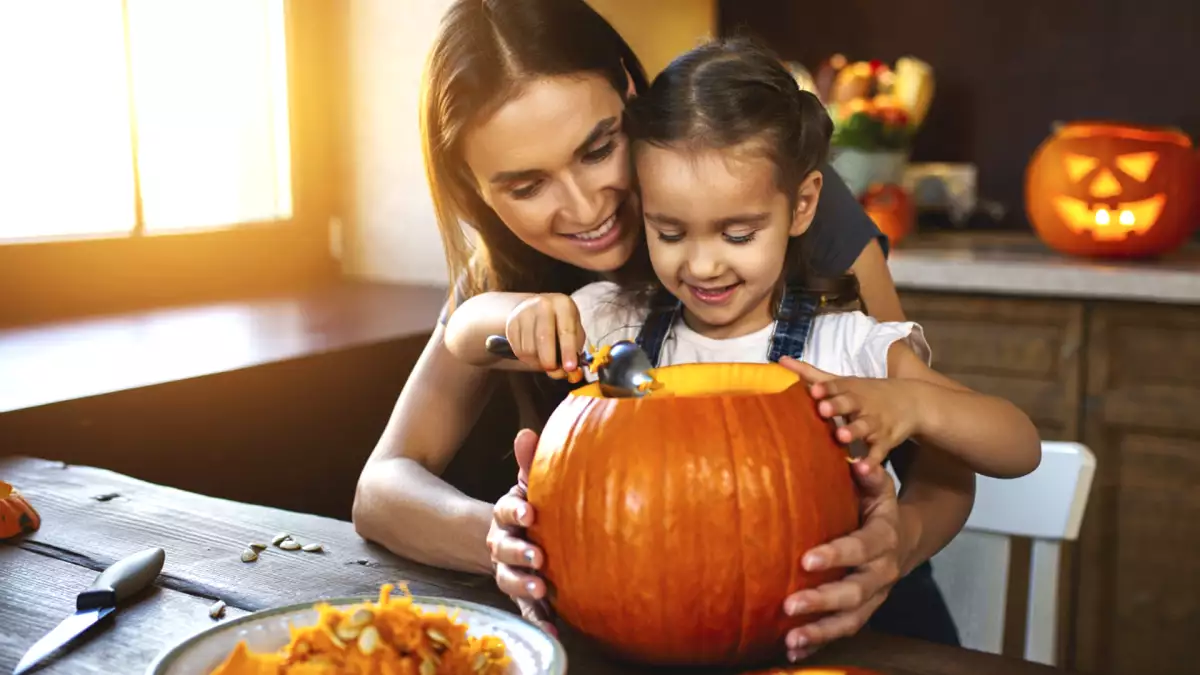How to carve a pumpkin at home and enjoy the Halloween ritual without cuts or scares

The table is ready: a large pumpkin, a serrated knife, a bowl for the seeds. Your daughter looks at you with the expectation of someone who is about to open a treasure. You, with a twinge of insecurity, remember that the last time you tried something similar was a piece of furniture from Ikea.
The first cut sounds hollow. She covers her ears and laughs. Out comes a sweet, earthy, unmistakably autumnal smell. From that instant on, the plan ceases to be an art project and becomes a small domestic adventure.
Carving a pumpkin is not difficult, but there is a method to it. Neither internet videos nor the inspiration of the moment are enough. To do it well (and without scares) it is advisable to follow some clear steps.
1. Choose the right pumpkin (and not just any pumpkin from the supermarket).
Although they may look the same, not all pumpkins are carved the same. Cooking pumpkins, the ones you use to make cream or soup, tend to have tougher skin and very dense flesh: perfect for eating, but a nightmare to carve.
For carving, look for the so-called "Halloween pumpkins" or "carving pumpkins", grown expressly for decoration. Their rind is thinner, the interior more hollow and the texture less stringy. You will find them in markets or garden stores during October; they are usually lighter and have that characteristic deep orange color.
When choosing, pay attention to three things:
- Firmness: it should be whole, with no soft spots or cracks.
- Medium size: between 20 and 30 centimeters in diameter is ideal for safe handling.
- Stable base: if it wobbles, place it on a damp cloth to check that it can stand firm.
Even carving pumpkins are still hard at first. Don't be discouraged if the first cut is difficult; the skin will yield quickly with the right tool.
2. Prepare the space, the tools (and the patience).
Carving a pumpkin is not improvised. Prepare a large table, cover it with paper or an old tablecloth and make sure you have good light. Ideally, a firm, stable surface where you can exert some force without risk of the pumpkin slipping or falling. Avoid unstable tables, glass surfaces or ceramic hobs. One last detail that makes a difference: place a damp cloth under the pumpkin. This way it won't move when you start cutting, just when you need to concentrate the most.
Place everything you need within easy reach:
- A small, stiff serrated knife, never a flexible blade: blades that bend or vibrate are dangerous and tend to slip out of the cut.
- If you can, use a specific pumpkin carving kit; they are sold at hardware or garden stores and are surprisingly effective and safe.
- A soup spoon or metal scoop to scoop out the inside.
- A washable marker to mark the design.
- A large bowl or container for seeds and debris.
Avoid large kitchen knives or improvised punches: they do not give more precision, only more risk.
And, if the little ones in the house are going to participate, let them do the safe parts: drawing, picking up or cleaning.
3. Cut and empty calmly (the most demanding part)
When it's time for the first cut, the skin of the pumpkin feels harder than you imagined. That's okay: it's part of the process. You don't need strength, just firmness and method.
Start by removing the lid around the stem, cutting inward at an angle, as if you were marking a plug (you can also cut the base, if you prefer a more stable surface to place the candle or light). Do this with short, sure strokes. If you have specific carving tools, use them: they look like a toy, but they cut the pumpkin accurately and without risk.
Once opened, the inside is easy to work with. With a solid metal spoon or ladle, scrape out the pulp until the walls are one or two centimeters thick. The thinner they are, the more the light inside will shine through.
The moist texture and hollow sound announce that you're on the right track. Your child will probably want to participate: letting her scoop out the pulp or collect the seeds is also part of the ritual.
4. Draw, mark, enjoy
The technical part is over. Now the game begins. With the pumpkin clean and empty, draw the design with a washable marker or paste a printed template. No need to get complicated: triangular eyes and crooked smiles are still the most expressive.
Let her draw first. You'll do the cutting. If you make small holes with a fine drill bit or awl along the lines, the knife or saw will follow the path with less effort.
Cut slowly, from the center out. If something breaks, don't fix it: imperfections give it life. When you're done, put the tools away and clean the table.
5. The most magical part: the light
Finally, we can place a tea light or a small LED light inside. If you use a real candle, make sure the pumpkin is on a stable surface and never leave it burning unattended.
When the light flickers inside, everything makes sense: the pumpkin transforms, the house becomes warmer and the darkness seems a little less dark.
Therein lies the magic: in something as simple as a candle inside a hollow fruit, and in the shared memory of creating it together.
6. Enjoying the result
All that remains is to admire the result. No need to say anything to understand that, whether it turns out better or worse, you will be satisfied, especially if you have shared the process with the kids. Because the important thing, as almost always, was not the pumpkin, but the time shared and everything learned along the way.
 Patricia González
Patricia González
Comments